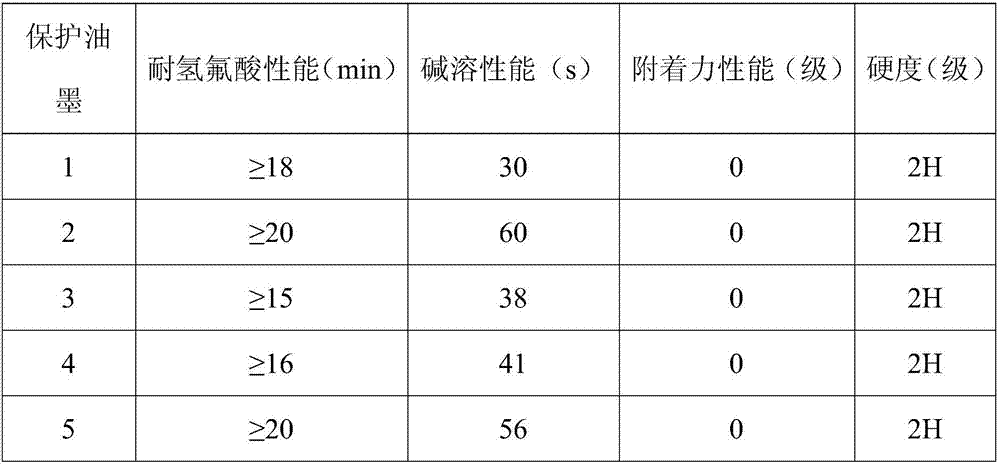Protective printing ink for process of acid-etching glass as well as preparation method and application thereof
A technology for protecting ink and acid etching, which is applied in the printing field, and can solve the problems of obtaining specific patterns on the glass surface, poor hydrofluoric acid corrosion resistance, long dissolution and demoulding time, etc., to achieve reduced penetration rate and good solubility , polymerization degree and high density effect
- Summary
- Abstract
- Description
- Claims
- Application Information
AI Technical Summary
Problems solved by technology
Method used
Image
Examples
Embodiment 1
[0055] Prepare protection ink 1 by following steps:
[0056] The WDS-1161 type o-methyl novolak epoxy acrylic resin (solid content is 68%, weight-average molecular weight is 10000, acid value 80mgKOH / g) produced by 50g Wuxi Vidus Electronic Materials Co., Ltd., 5g photopolymerizable monomer Dipentaerythritol hexa(methacrylate) ester, 3g photopolymerization initiator 2,4,6-trimethylbenzoyl diphenyl phosphine oxide, 3g NPES-904 type epoxy resin produced by Taiwan Nanya Company, 1g Dow Corning Company Produced Z-6040 coupling agent, 10g of methyl ethyl ketone and propylene glycol dimethyl ether acetate prepared in a volume ratio of 1:1 solvent, 30g of filler talcum powder, 0.5g of BYK-333 type leveling agent produced by German BYK company agent, 0.1g of IHT-IN 510 inhibitor produced by Beijing Yingli Company, and 0.3g of pigment phthalocyanine blue are mixed evenly, and ground by a three-roll mill for 10 times, so that the fineness of the components existing in solid form is ≤ 8...
Embodiment 2
[0059] Prepare protection ink 2 by following steps:
[0060] Difference with embodiment 1 is that the add-on of o-methyl novolak epoxy acrylic resin is 45g, wherein the solid content of o-methyl novolac epoxy acrylic resin is 30%, weight average molecular weight is 20000, and acid value is 100mgKOH / g.
[0061] Example 2 Obtained protective ink 2.
Embodiment 3
[0063] Prepare protection ink 3 by following steps:
[0064] The difference from Example 1 is that the addition of o-methyl novolac epoxy acrylic resin is 60g, wherein the solid content of o-methyl novolac epoxy acrylic resin is 70%, and the acid value is 50mgKOH / g.
[0065] Example 3 Obtained protective ink 3.
PUM
| Property | Measurement | Unit |
|---|---|---|
| Acid value | aaaaa | aaaaa |
| Acid value | aaaaa | aaaaa |
| Acid value | aaaaa | aaaaa |
Abstract
Description
Claims
Application Information
 Login to View More
Login to View More - R&D
- Intellectual Property
- Life Sciences
- Materials
- Tech Scout
- Unparalleled Data Quality
- Higher Quality Content
- 60% Fewer Hallucinations
Browse by: Latest US Patents, China's latest patents, Technical Efficacy Thesaurus, Application Domain, Technology Topic, Popular Technical Reports.
© 2025 PatSnap. All rights reserved.Legal|Privacy policy|Modern Slavery Act Transparency Statement|Sitemap|About US| Contact US: help@patsnap.com



